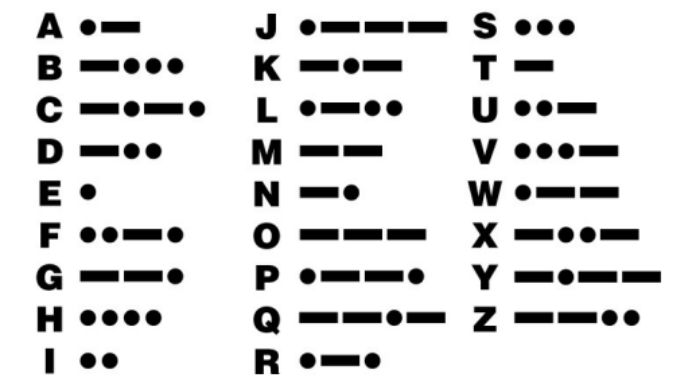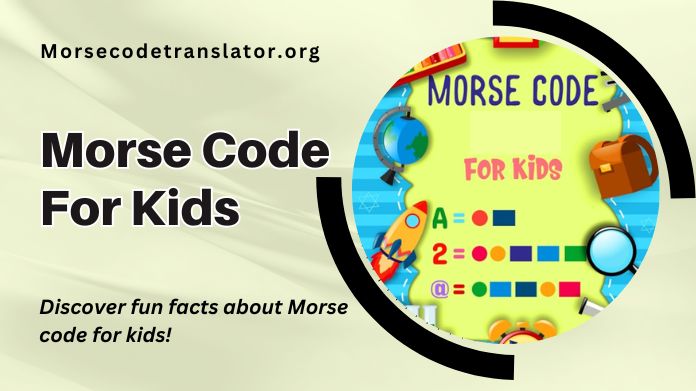Morse code, a timeless method of communication that uses a combination of dots (short signals) and dashes (long signals) to represent letters, numbers, and punctuation, holds a unique place in the history of technology.
Despite being over 180 years old, Morse code fascinates, especially when introduced to Morse code for kids or Morse code lessons for kids. It’s not just about learning a series of dots and dashes; it’s about connecting with a pivotal moment in the development of communication.
Here, we explore Morse code, focusing on making it accessible and fun Morse code for kids, filled with interesting facts that spark curiosity.
The Origins of Morse Code

Morse code was invented in the early 1840s by Samuel Morse and Alfred Vail. Initially developed to make long-distance communication possible via the telegraph, it quickly became a vital tool in global communication.
The first message transmitted by Morse code over a telegraph line was “What hath God wrought,” sent on May 24, 1844, marking a new era in how humans connect over vast distances.
While Morse code is primarily known for its dots (·) and dashes (—), it encompasses more than just these symbols. It includes spaces separating letters and words, making it a comprehensive coded language.
Each letter and number is represented uniquely, making Morse code a fun, puzzle-like language for kids to decode and encode messages.
Morse Code in Nature
Interestingly, the rhythm of Morse code mirrors patterns found in nature. For example, the rhythmic tapping of a woodpecker can resemble Morse code, and the long and short chirps of certain birds can sound surprisingly similar to Morse transmissions.
This natural connection can be a fascinating discovery for kids, showing them that patterns identical to Morse code exist in the world around us. One of the most famous uses of Morse code was during the tragic sinking of the RMS Titanic in 1912.
The wireless operators aboard the Titanic sent out distress signals in Morse code, which were received by nearby ships and onshore radio stations. This historical event showcases Morse code’s critical role in emergencies and rescues at sea.
Morse Code in Modern Technology
Though it might seem like a relic of the past, Morse code has found its place in modern technology. For instance, it’s used in assistive technology to help individuals with disabilities communicate.
The simplicity of the dot-and-dash system makes it adaptable for various communication devices, including apps that translate taps or blinks into text.
Morse Code For Kids: Learning Morse Code Through Play

There are numerous fun ways to introduce Morse code for kids:
1. Morse Code Jewelry: Kids can create bracelets or necklaces using beads to represent different Morse code symbols, spelling out their names or secret messages.
2. Flashlight Messages: Using flashlights to blink Morse code messages in the dark can be an exciting game for kids, teaching them how to communicate silently and from a distance.
3. Sonic Experiments: Creating Morse code messages with musical instruments, claps, or stomps can turn a lesson into a lively activity, helping kids remember the codes through rhythm.
Morse Code for Safety
Teaching Morse code for kids can also have practical benefits. For example, knowing how to signal “SOS” (· · · — — — · · ·) in Morse code can be a lifesaving skill in emergencies where conventional communication methods are unavailable.
This simple message has universally been recognized as a distress signal, showcasing the enduring importance of Morse code in safety and rescue operations.
The Global Language
Morse code was designed to transcend language barriers, making it one of the first global communication methods.
Its simplicity and universality meant that people from different linguistic backgrounds could communicate, especially in maritime contexts where it was extensively used for international distress signals.
Morse Code in Space
Beyond Earth, Morse code has also made its mark in space exploration. For instance, the NASA Voyager missions carry golden records with information about humanity, including greetings in 55 languages and a Morse code message.
This highlights Morse code’s role as a universal language intended to communicate with potential extraterrestrial intelligence.
Cultivating Patience and Focus
Learning Morse code teaches children more than just a new way of communicating; it cultivates patience, focus, and attention to detail.
Deciphering and encoding messages in Morse code can be a meticulous process that rewards careful listening and concentration, valuable skills in any area of study or life.
Conclusion
Morse code for kids is not merely an educational curiosity; it’s a gateway to exploring history, technology, and the natural world. Its simplicity, combined with its rich historical context, makes Morse code an engaging subject for children.
Introducing Morse code through fun facts and interactive activities can spark children’s interest in communication technology, history, and the wider world.
Morse code’s legacy, from its crucial role in historical events to its application in modern technology and space exploration, underscores its significance as a fascinating and enduring form of communication.
